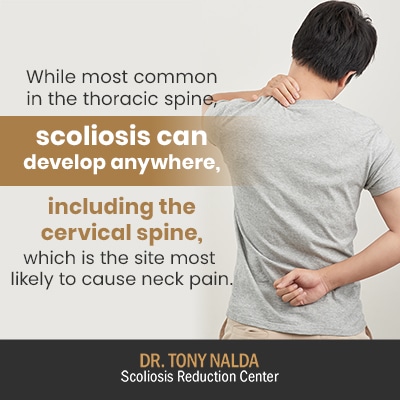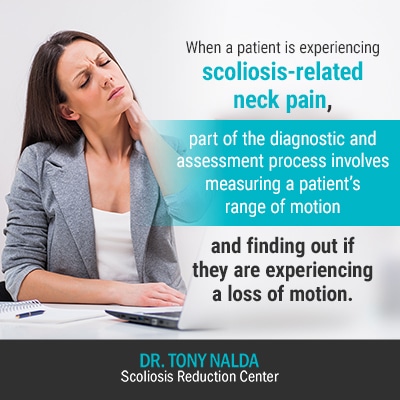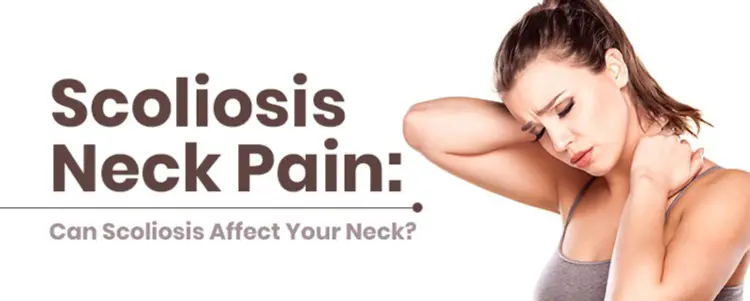Scoliosis has the potential to cause pain in different areas of the body, and not just the back. While not commonly painful in children and adolescents, back and neck pain are common complaints of adults living with the condition. Scoliosis neck pain is often associated with a loss of motion in the cervical spine (neck), and particularly for scoliosis that develops along the cervical spine, neck pain can be a symptom.
Scoliosis, as an abnormal sideways spinal curvature, can develop anywhere along the spine from the neck to the lower back. As scoliosis is known to cause spinal rigidity, if there is a loss of motion in the cervical spine, this can disrupt head positioning and cause related neck pain.
Before we move on to the specifics of scoliosis neck pain, including assessment and treatment, let’s first touch on some of the basics of scoliosis.
Understanding Scoliosis
When a person develops scoliosis, it means they have an abnormal sideways curvature of the spine, with rotation, that causes the spine to become misaligned.
The spine is naturally curved so that when viewed from the side, it has a soft ‘S’ shape, and when viewed from the front or back, it appears straight. The spine’s natural curvatures give it increased strength, flexibility, and allow it to evenly distribute weight and stress throughout.
When an unnatural curvature develops, as with scoliosis, the body can try to compensate by adding unnatural curves in other areas of the spine, disrupting its overall biomechanics.
As scoliosis is progressive, this means it’s in its nature to worsen over time, especially if left untreated, or not treated appropriately. Scoliosis can vary widely in severity ranging from mild to moderate and severe to very severe.
The larger a scoliotic curve, the more severe the condition, and the more likely it is to cause postural changes and compression that can lead to pain.
An important characteristic of scoliosis to understand is that different age groups experience scoliosis-related pain very differently.
Scoliosis and Pain in General
While every case is different, generally speaking, children and adolescents don’t find their conditions painful, but adults, however, experience scoliosis-related pain more frequently.
This is understood as the result of growth and skeletal maturity. In children and adolescents who have not yet reached skeletal maturity, their spines are constantly growing and lengthening, and this motion counteracts the compressive force of the abnormal curvature; in adults who are no longer growing, their spines have settled due to gravity and maturity, so their spines are vulnerable to the curvature’s compression of the spine and its surrounding muscles and nerves.
Scoliosis introduces a lot of uneven forces to the body, so an abnormal spinal curve can introduce adverse pressure to different areas of the back, including the spine’s surrounding muscles.
Another important characteristic of scoliosis is that it can develop in different regions of the spine. The three main spinal sections are: cervical (neck), thoracic (middle and upper back), and lumbar (lower back).

While most common in the thoracic spine, scoliosis can develop anywhere, including the cervical spine, which is the site most likely to cause neck pain.
Can Scoliosis Cause Neck Pain?
Scoliosis can cause pain in different areas of the body and in different ways. Again, every case is different as there are a number of important patient and condition characteristics that shape a person’s experience of life with the condition: patient age, condition severity, condition type, and curvature location.
As mentioned, children and adolescents don’t commonly find scoliosis painful, but it should be mentioned that approximately 20 percent of adolescents living with scoliosis do report some related back and/or muscle pain.
It’s important to understand that it’s not just the structural elements of the spine that maintain its natural curvatures and alignment; it’s also the spine’s surrounding muscles that help support and stabilize it.
As mentioned, the uneven forces that scoliosis introduces don’t just put pressure on the spine, but also its surrounding muscles and nerves. In cases of scoliosis that are causing postural changes affecting the body’s overall symmetry, this means the body’s muscles have to work harder to try and counteract these changes and still provide the spine with support.
Particularly when scoliosis affects the cervical spine, neck pain can be a symptom, especially in adults, or in cases that are progressing as spinal rigidity can increase alongside curvature size.
While every case is different, the larger the abnormal spinal curvature, the more likely it is to cause postural changes and compression of the spine, its surrounding muscles, and nerves.
A stiff spine can lead to a loss of motion which can lead to a number of structural issues, and as a scoliotic spine gets more rigid, this means the spinal bones (vertebrae) are losing their ability to move, and this can further exacerbate postural changes as the body tries to adjust to the curvature’s presence.
A condition called ‘military neck’ is a good example of how postural distortion can lead to further structural issues and pain (although more common in adults).
Military Neck
Also known as ‘cervical kyphosis’, military neck is a condition that involves having an abnormally-straight neck as the spine’s natural kyphosis (forward curve) is lost.
If scoliosis has affected the cervical spine and caused disc degeneration, changes to posture, or other structural issues, military neck can develop as a related condition; conversely, chronic poor posture can also cause the development of military neck, which if left untreated can cause structural issues that can lead to the development of other issues throughout the spine.
Military neck earned its name by giving people with the condition the appearance of standing at attention.
When military neck is present, the shift in posture, known as ‘forward-head posture’, increases the weight of the head on the neck and spine that supports it. This introduces adverse tension and can disrupt the entire spine’s biomechanics.
In addition, the muscles that support the cervical spine are strained in their effort to support the increasing weight of the head due to the shift in posture caused by the loss of cervical kyphosis.
As scoliosis, and other spinal conditions, don’t just affect the spine precisely at the site of the abnormal spinal curvature, but also disrupts the entire biomechanics of the spine, this is why proactive treatment for scoliosis involves the whole spine.
The adverse mechanical tension that military neck introduces can actually lead to additional spinal issues such as deformation of the dura, the spinal cord, and nerve roots in the cervical canal. The condition can also stretch and squeeze the arteries of the neck and lead to reduced blood flow to the brain.
Symptoms of military neck can include:
- Stiffness in the area
- Decreased range of motion
- Headaches
- Coordination issues
- Neck pain
- Radiating pain into the fingers and toes
- Muscle weakness
- Postural disruption
Not everyone with scoliosis of the cervical spine will automatically develop military neck, and conversely, not everyone with military neck will automatically develop scoliosis, but there is a connection as the spinal conditions, especially if left untreated, can lead to intervertebral disc degeneration, and this can impair the spine’s ability to maintain its natural and healthy curves and alignment.
In addition to neck pain caused by an abnormal curvature of the cervical spine and related muscle pain, scoliosis can also cause headaches that can range from intermittent and mild to chronic and debilitating.
Scoliosis and Headaches
Patients who are experiencing scoliosis-related neck pain can experience tension headaches as an additional symptom.
When the muscles of the neck are stiff and tight due to a loss of motion, the head experiences adverse tension, and this can lead to headaches of varying levels of intensity.
In addition, scoliosis can also cause a disruption to the flow of cerebrospinal fluid (CSF) that passes through the spinal canal. CSF provides cushioning and protection for the brain and spine, in addition to delivering nutrients and waste removal between the brain and spinal cord.
Abnormal spinal curvatures can lead to changes in CSF levels that can cause painful headaches, some reaching migraine status.
As mentioned, a lot of scoliosis-related pain comes from a loss of motion, and neck pain is no exception, so let’s move on to how a loss of motion is assessed and addressed.
Loss of Motion and Scoliosis-Related Neck Pain

When a patient is experiencing scoliosis-related neck pain, part of the diagnostic and assessment process involves measuring a patient’s range of motion and finding out if they are experiencing a loss of motion.
This is important information because stiff muscles and vertebrae can cause a loss of motion, which can lead to pain and the development of further structural issues, especially if left untreated, or not treated appropriately.
Here at the Center, I use X-rays, when needed, and digital measuring devices to assess neck flexion (bending forward) and extension (bending backward). This helps me determine the level of motion loss a patient is experiencing.
This information helps me craft a treatment plan with the most potential for successful results as I know how much work needs to be done to restore motion; this helps improve the spine’s responsiveness to treatment and allows for scoliosis-specific exercises and stretches to be effectively integrated into the treatment plan.
A patient’s level of motion is assessed by having them bend their neck forward, while lowering their chin to their chest, and taking X-ray images, if necessary, in that position to measure flexion; then we pose them in the opposite position with the head tilted back as far as possible and take more images to measure extension. I also pay attention to the level of pain, if any, these movements are causing.
Images taken in these positions give me a clear idea of how a patient’s range of motion has been affected by their scoliosis. It’s not uncommon for patients to be unaware of a loss of motion, so it’s important for me to know exactly what we are dealing with in the interest of designing a comprehensive and effective treatment plan.
The individual bones of the spine (vertebra) should have a healthy and normal range of motion. When I see someone who is experiencing neck pain, I often find that they have a loss of motion in multiple vertebrae, and this can lead to many spinal issues.
By prioritizing the spine’s overall function and health in treatment, my goal is to return flexibility and motion to those joints of the spine that have lost it, as this improves the spine’s biomechanics.
So if scoliosis-related neck pain has become an issue, and we know that a loss of motion is part of the problem, now what?
Treatment for Scoliosis-Related Neck Pain
Here at the Scoliosis Reduction Center®, my treatment goal is always to restore the spine’s overall health and function. As scoliosis is a structural condition, it needs to, first and foremost, be impacted on a structural level.
Both for my adult and adolescent patients, whether they are experiencing scoliosis-related neck pain or not, my treatment plans address the underlying structural issues the scoliosis is causing; if these structural issues aren’t addressed, the spine’s overall function won’t be improved.
Through my proactive and integrative approach, I’m able to fully customize each and every treatment plan so the specifics of each patient’s condition are addressed.
Through combining multiple scoliosis-specific treatment disciplines such as chiropractic care, in-office therapy, custom-prescribed home exercises, and specialized corrective bracing, I work with my patients to restore the spine’s biomechanics, increase the spine’s flexibility, strengthen weak muscles so the spine’s better supported and stabilized, and reduce the curvature.
My treatment protocol is to proactively address the underlying cause of any scoliosis-related pain, which is structural, so by impacting the condition on a structural level, whether the patient is experiencing related pain or not, this is the means by which the spine’s overall function and biomechanics is restored; by doing so, the issues causing the pain are addressed as the abnormal curvature is reduced and as much of the spine’s natural and healthy curves as possible are restored.
In particular, along with scoliosis-specific targeted chiropractic adjustments, isometric exercises can be a big part of my treatment plans, as can laying on spinal-molding rolls to work on improving the neck’s healthy kyphosis.
As the neck’s healthy curve is restored, adverse spinal tension is addressed, and scoliosis-related neck pain is reduced and/or eliminated.
Regardless of how the different treatment disciplines are apportioned in customizing treatment plans, the underlying structural issue causing any pain is the primary focus of treatment as this involves treating the condition itself, and not just its symptoms.
Conclusion
So to clearly answer the question, can scoliosis affect your neck? Yes, it most certainly can. While every case is different, curvature location plays a large role in whether neck pain becomes a symptom as abnormal cervical curvatures, located closest to the neck, and thoracic curves are more commonly associated with neck pain than lumbar curvatures.
However, as the spine’s natural curvatures and alignment are dependent upon one another, even an abnormal lumbar curvature can disrupt the cervical kyphosis if the spine responds by putting in a counteractive curve in an effort to address the asymmetry.
In addition, scoliosis is known to cause muscle pain and can lead to a disruption in cerebrospinal fluid, known to cause neck pain and headaches.
Chronic poor posture, and/or postural distortions caused by scoliosis, can lead to the development of a condition known as ‘military neck’ that involves a loss of the neck’s healthy kyphosis, and this can lead to a loss of motion in the vertebrae of the cervical spine and strained neck muscles in their effort to support it.
Scoliosis neck pain is commonly associated with a loss of motion in the area, so by assessing the level of motion loss, I can integrate this information into a customized treatment plan and work to restore that loss of motion so adverse tension is removed from the spine, its surrounding muscles, and nerves.
Here at the Scoliosis Reduction Center®, I work proactively to impact patients’ conditions on a structural level as this is the underlying cause of any scoliosis-related pain and symptoms.





